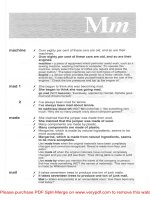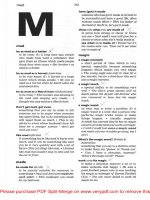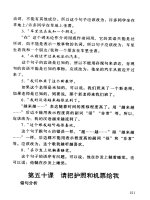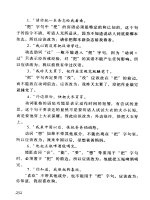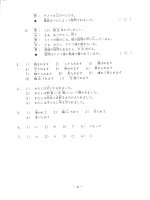2 6 earths weather (earth science)
Bạn đang xem bản rút gọn của tài liệu. Xem và tải ngay bản đầy đủ của tài liệu tại đây (2.73 MB, 14 trang )
Genre
Nonfiction
Comprehension Skill
Draw Conclusions
Text Features
• Captions
• Diagrams
• Glossary
Science Content
Weather
Scott Foresman Science 2.6
ISBN 0-328-13785-5
ì<(sk$m)=bdhif < +^-Ä-U-Ä-U
Vocabulary
condense
evaporate
hibernate
hurricane
lightning
migrate
tornado
water cycle
What did you learn?
1. What is one difference between
fall and spring?
2. What is the difference between
hibernating and migrating? How
are these two behaviors similar?
3.
by Christine
Wolf
Sometimes
wet weather can be dangerous.
In your own words, write to tell
about the different kinds of
dangerous weather. Use words
from the book as you write.
Picture Credits
Every effort has been made to secure permission and provide appropriate credit for photographic material.
The publisher deeply regrets any omission and pledges to correct errors called to its attention in subsequent editions.
Photo locators denoted as follows: Top (T), Center (C), Bottom (B), Left (L), Right (R), Background (Bkgd).
Opener: Digital Vision; 2 (R) Digital Vision; 3 Digital Vision; 4 Digital Vision; 5 (T, B) Joanna Van Gruisen/Ardea;
8 (TR, BR) Getty Images; 9 (TL, BL) Getty Images; 10 (R, BL) Getty Images; 11 (TR) Digital Vision; 12 (R) Getty Images;
14 (R) Getty Images; 15 (TR) William H. Mullins/Photo Researchers, Inc.; 16 (R, Bkgd) Getty Images; 18 Digital Vision;
20 Digital Vision; 21 Getty Images; 22 Getty Images.
Unless otherwise acknowledged, all photographs are the copyright © of Dorling Kindersley, a division of Pearson.
ISBN: 0-328-13785-5
Copyright © Pearson Education, Inc. All Rights Reserved. Printed in the United States of America.
This publication is protected by Copyright, and permission should be obtained from the publisher prior to any
prohibited reproduction, storage in a retrieval system, or transmission in any form by any means, electronic,
mechanical, photocopying, recording, or likewise. For information regarding permission(s), write to
Permissions Department, Scott Foresman, 1900 East Lake Avenue, Glenview, Illinois 60025.
3 4 5 6 7 8 9 10 V010 13 12 11 10 09 08 07 06 05
4.
Draw Conclusions The ground
is wet. The air is cool. There are
tulips poking through the soil.
Baby geese are sitting near their
mother in the green grass. What
season do you think it might be?
What makes
weather wet
or dry?
What is weather?
Rain, hail, and snow
are kinds of wet weather.
Clouds are made of lots
of water droplets and tiny
bits of ice. The clouds get
big and heavy.
When the air is warm
the droplets can fall to the
ground as rain. When the
air is cold they may fall
down as sleet or snow.
Weather happens because of changes
in Earth’s temperature. Days can be hot
or cold, wet or dry. Different kinds of clouds
and wind are also a part of weather.
2
3
Some places do not get a lot of rain. These
places have very dry weather. When there is not
enough rain for plants and animals to live,
it is called a drought.
Some places are wet and green in winter.
In the summer they can be dry and brown.
4
5
The Water Cycle
Clouds rise
and cool, and
rain falls.
Water vapor rises
from the land.
Earth’s water keeps moving between the
oceans, the sky, and the land. Water evaporates
from the ocean and rises to form clouds.
The water vapor in clouds gets cold and
changes, or condenses, back to water droplets.
The water droplets fall back to the ground.
Rain gathers in rivers and runs to oceans. The
Sun heats the oceans and the cycle begins again.
Clouds form as
the vapor cools.
Water vapor
rises from
the ocean.
Water flows
back to the ocean.
The wheel on a bicycle goes
around in a circle. Water in Earth’s
water cycle also goes round and round.
6
7
The Four
Seasons
Many parts of
the world have four
seasons. They are
spring, summer, fall,
and winter. Each
season has its own
weather.
spring
summer
The four seasons
together last one
year. In each season
days can be longer
or shorter. Animals
and plants behave
differently in each
season too.
fall
8
winter
9
Spring
Spring is the season
of change and growth.
Often, spring has rainy
days and cool nights.
Small plants begin to
grow in spring.
You may see new
green leaves on trees.
Many baby animals are
born in the spring. Lots
of flowers can bloom.
What is spring like
where you live?
10
11
Summer
Summer is often hot
and sunny. Summer has
more hours of daylight
than spring. The Sun is
high in the sky. Many
people like to be outside in
the summer.
Baby animals grow
up in the summer. Many
fruits and vegetables
get ripe in the summer.
What is summer like
where you live?
12
13
Fall
In fall the temperature
cools down. There are fewer
hours of daylight than in
summer. Leaves may change
color, and some leaves fall
off the trees.
In the fall many animals
begin to prepare for the
winter. Some animals, such
as squirrels, gather and
store food.
Other animals, such
as Canada geese, travel,
or migrate, to warmer
places. What is fall like
where you live?
14
15
Winter
Winter is the coldest
season. In many places,
snow falls, lakes and
ponds freeze, and icicles
form. Winter has the
fewest hours of daylight.
The Sun is low in the sky.
Some animals
hibernate in winter.
Hibernate means to
hide away and sleep.
Animals that hibernate
fatten up so their bodies
can stay warm as they
sleep. What is winter
like where you live?
16
17
Dangerous
Weather
Sometimes wet weather
can be dangerous.
Thunderstorms often form
on hot summer days.
They can bring heavy
rain, hail, thunder, and
lightning.
Lightning is a flash of
light in the sky. Thunder
is the sound that follows
lightning.
Staying Safe In
A Thunderstorm
Staying safe from lightning means
finding shelter in a building. It also
helps to stay away from water, metal
objects, and trees.
18
19
Staying Safe
In a Tornado
Tornadoes are made up
of strong winds that move in
a circle. Air inside a tornado
acts like a giant straw.
Everything in a tornado’s path
gets sucked up into the sky.
Tornadoes can be unexpected.
If you are ever caught in a tornado
you should find shelter indoors.
You should stay in the basement or
under the stairs. Keep away from
windows, water, and metal objects.
20
21
Staying Safe
In a Hurricane
When many thunderstorms join together,
a hurricane may form. Heavy rains fall during
hurricanes. Strong winds blow and knock down
buildings and trees.
22
When a hurricane is coming, people who
live near the beach move away from the water
so they can stay away from huge waves. People
board up windows and bring inside things that
might fly around.
23
Vocabulary
condense
Glossary
evaporate
hibernate
hurricane to change from water vapor
condense
lightning to water droplets
migrate
evaporate
tornado to change from water to
water cyclewater vapor
hibernate to hide away and sleep
through winter
hurricane
a very strong storm that starts
over the ocean
lightning
a flash of light in the sky
migrate
to move to a warmer place when
winter is coming
Picture Credits
Every effort has been made to secure permission and provide appropriate credit for photographic material.
The publisher deeply regrets any omission and pledges to correct errors called to its attention in subsequent editions.
Photo locators denoted as follows: Top (T), Center (C), Bottom (B), Left (L), Right (R), Background (Bkgd).
tornado
a circling column of air
Opener: Digital Vision; 2 (R) Digital Vision; 3 Digital Vision; 4 Digital Vision; 5 (T, B) Joanna Van Gruisen/Ardea;
8 (TR, BR) Getty Images; 9 (TL, BL) Getty Images; 10 (R, BL) Getty Images; 11 (TR) Digital Vision; 12 (R) Getty Images;
14 (R) Getty Images; 15 (TR) William H. Mullins/Photo Researchers, Inc.; 16 (R, Bkgd) Getty Images; 18 Digital Vision;
20 Digital Vision; 21 Getty Images; 22 Getty Images.
water cycle the movement of water from Earth
to the sky and back again
Unless otherwise acknowledged, all photographs are the copyright © of Dorling Kindersley, a division of Pearson.
ISBN: 0-328-13785-5
Copyright © Pearson Education, Inc. All Rights Reserved. Printed in the United States of America.
This publication is protected by Copyright, and permission should be obtained from the publisher prior to any
prohibited reproduction, storage in a retrieval system, or transmission in any form by any means, electronic,
mechanical, photocopying, recording, or likewise. For information regarding permission(s), write to
Permissions Department, Scott Foresman, 1900 East Lake Avenue, Glenview, Illinois 60025.
24
3 4 5 6 7 8 9 10 V010 13 12 11 10 09 08 07 06 05
What did you learn?
1. What is one difference between
fall and spring?
2. What is the difference between
hibernating and migrating? How
are these two behaviors similar?
3.
Sometimes
wet weather can be dangerous.
In your own words, write to tell
about the different kinds of
dangerous weather. Use words
from the book as you write.
4.
Draw Conclusions The ground
is wet. The air is cool. There are
tulips poking through the soil.
Baby geese are sitting near their
mother in the green grass. What
season do you think it might be?



